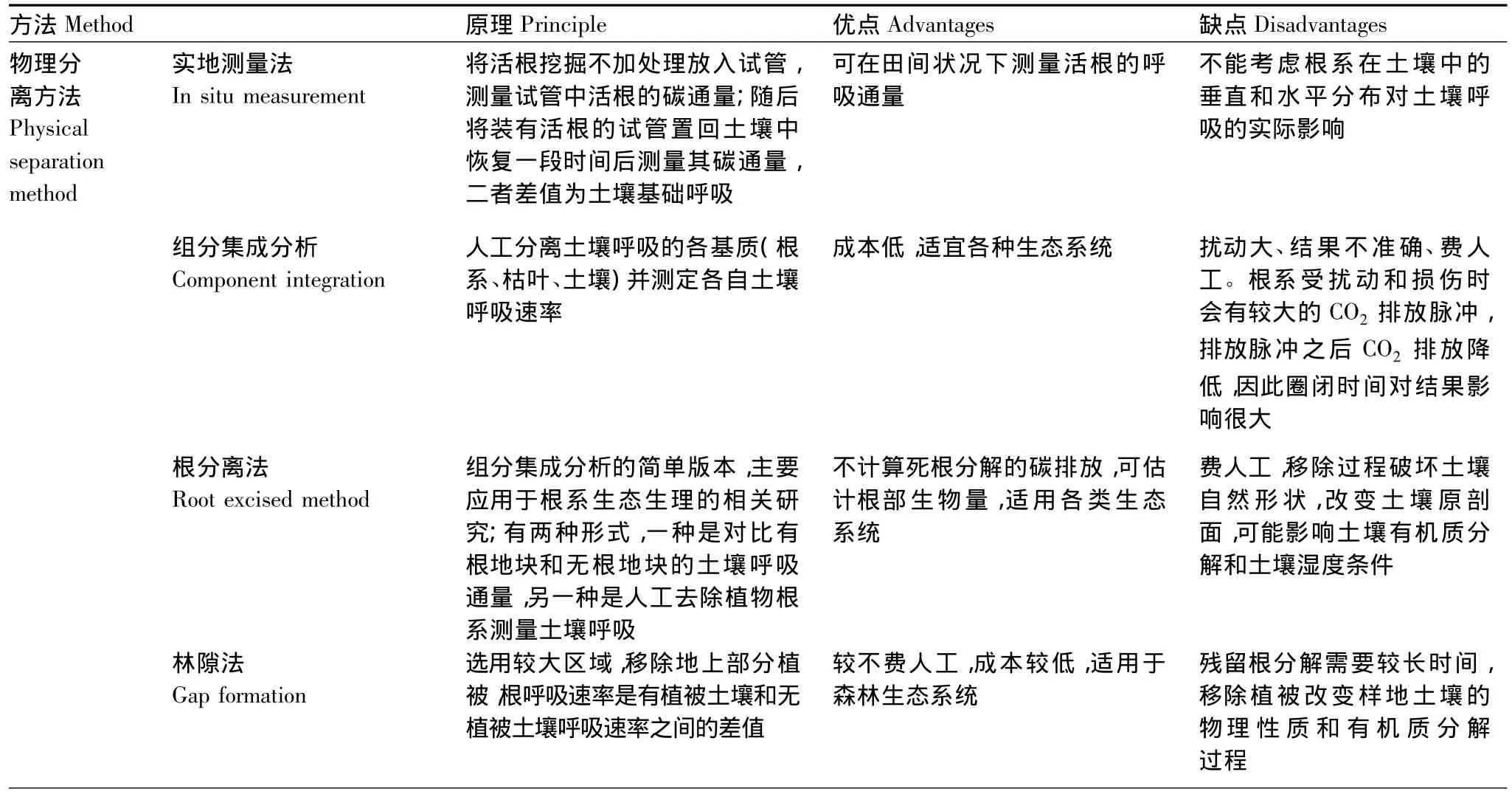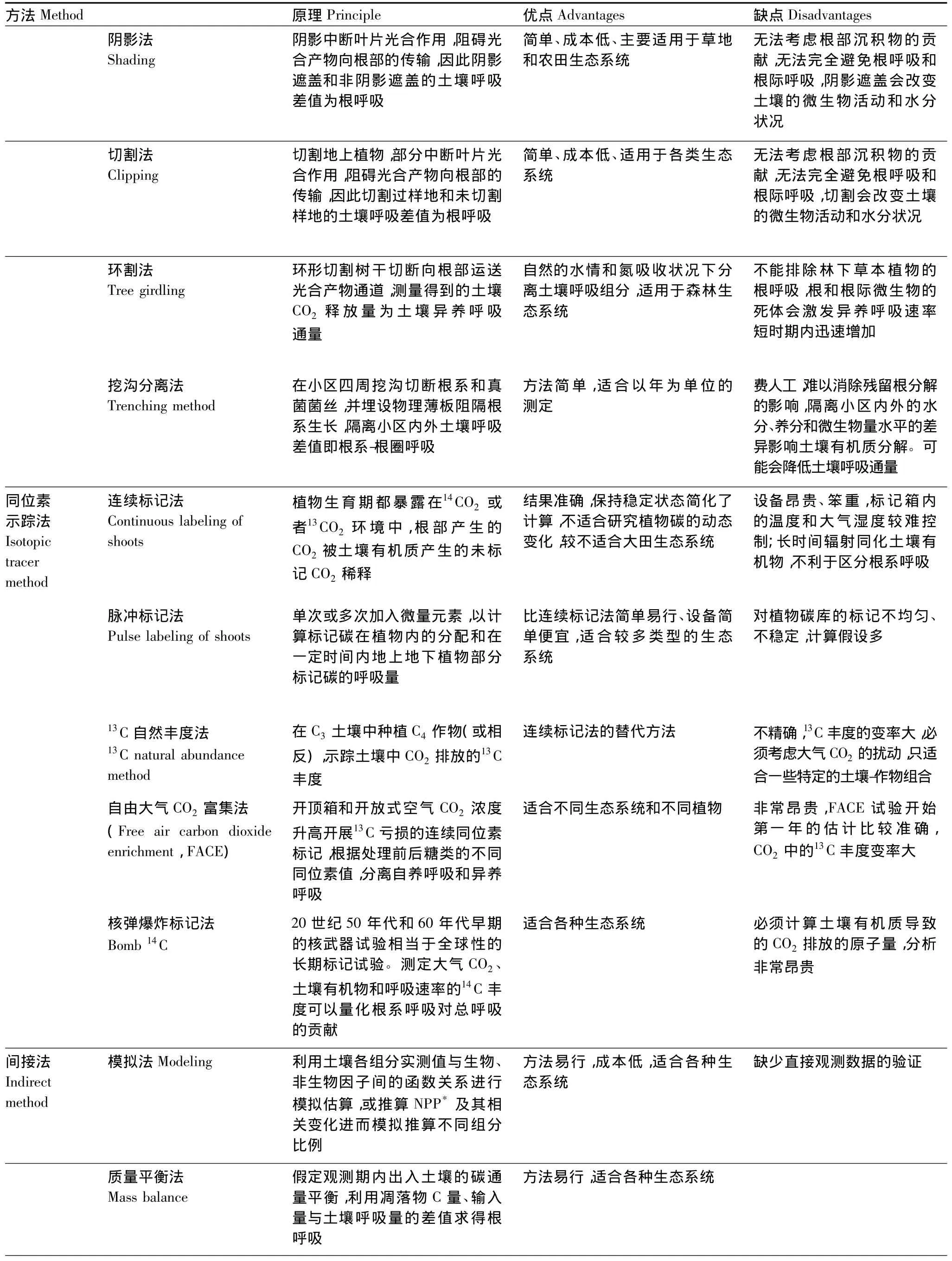土壤呼吸组分分离技术研究进展
2013-12-16陈敏鹏李银坤梅旭荣
陈敏鹏 ,夏 旭,* ,李银坤,梅旭荣
(1.中国农业科学院农业环境与可持续发展研究所,北京 100081;2.农业部农业环境重点实验室,北京 100081)
土壤呼吸(RS)是陆地生态系统中的第二大碳通量过程,是影响大气二氧化碳(CO2)浓度变化和全球碳循环的关键环节[1-2]。据估计,每年因土壤呼吸向大气释放的CO2为50—75PgC,约占大气碳库的10%,是化石燃料燃烧排放量的10倍以上[3-4],因此土壤呼吸速率的微小变化将直接导致大气CO2浓度和土壤碳累积速率的重大改变,从而加剧或减缓全球气候变化[5-6]。虽然对土壤呼吸的重要作用已达成广泛共识,科学界对土壤呼吸关键机制和过程的理解仍十分有限。土壤呼吸组分分离的相关研究可以帮助明确土壤呼吸和碳素周转过程及其对环境因子的响应和适应,这不仅可以推动全球碳循环模型的改进(例如,白化土壤呼吸和碳固定过程、精确估算生态系统净初级生产力[7],区分不同土壤呼吸组分对环境变量的敏感性等等[8-9]),而且有助于理解全球变化背景下土壤有机质的变化格局、识别和筛选减缓土壤有机碳分解的对策和措施,因此成为陆地生态系统碳循环、气候变化影响和适应、土壤与植物营养等领域的热点问题之一[10-12]。
农田生态系统是陆地生态系统最重要的组成部分。全球耕地面积约1381×102万hm2,占陆地总面积的10.6%[13],全球农田碳储量达170PgC,占陆地碳储量的10%以上[14]。,由于农业生态系统跟人类活动最密切,受人为干扰最大,它是唯一能在较短时间尺度实现调节功能的陆地生态系统碳库[15]。因此,研究农田生态系统土壤呼吸的过程和机理对促进温室气体减排增汇、气候变化适应、粮食安全保障和农业可持续发展都具有积极意义。
1 土壤呼吸的组分界定
土壤呼吸,也称土壤总呼吸,严格意义上包括未扰动土壤中产生CO2的所有代谢活动,它包括3个生物学过程和一个化学氧化过程,即微生物的呼吸和土壤有机质分解过程(即微生物呼吸)、植物根和根际有机体呼吸过程(即纯根和根际呼吸)、土壤动物呼吸过程(RF)和含碳物质的化学氧化过程[16-17]。由于后两个过程对土壤呼吸的贡献较小,机制尚不清楚,目前的相关研究主要集中于前两个生物学过程。由于各过程呼吸性质、呼吸主体、利用碳源、周转速率、时空变异性以及对环境因子的响应机制和适应性的显著差异,学者们对不同土壤呼吸进行区分,以深入理解土壤呼吸的生态过程和微观机制[18-20]。
在具体的研究中,由于区分标准和研究目的不同,研究者对土壤呼吸组分划分方式也不相同(图1)。最简单的两室模型根据呼吸主体不同将土壤呼吸区分为根呼吸(Rr)和微生物呼吸(Rb)[21]。多室模型则对上述两个过程进行了细化,一般的三室模型假设存在植物残留且激发效应(PE)对土壤呼吸的贡献较低,将土壤呼吸划分为根呼吸(Rr)、微生物呼吸或者土壤有机质(SOM)分解(Rb/SOM)以及根际共生体(菌根)呼吸/根际微生物呼吸(Rz),其中 Rr又称为自养呼吸(Ra)、Rb和 Rz合称为异养呼吸(Rh)[22-24]。Kuzyahov[25]根据利用碳源和碳周转速率的差异将土壤CO2通量分为5种主要来源:纯根系呼吸(Rr)、根际微生物呼吸、死亡植物残留物的微生物呼吸、源于有机质添加的土壤呼吸(激发效应)和源于有机质的基础土壤呼吸。
图1根据土壤组分界定的经典文献绘制而成[21,23,25,28],可看出,目前学术界尚未形成对土壤呼吸组分界定的一致意见,许多概念的边界仍十分模糊(例如土壤微生物呼吸的外延在文献中就有最广义、广义和狭义3种区分),争论焦点则集中在各呼吸过程的划分,尤其是根际周围各种呼吸过程的区分和界定方面[17,19]。例如,HOgberg等[26]认为没必要区分根际微生物呼吸和纯根呼吸,但Kuzyakov[27]坚持二者是不同过程。在实际研究中,区分纯根呼吸和根际微生物呼吸十分困难,多数文献测量的根呼吸都包括了纯根呼吸和部分根际微生物呼吸。

图 1 土壤呼吸不同过程的区分[21,23,25,28]Fig.1 Definition of different soil respiration processes[21,23,25,28]
2 土壤呼吸的组分分离技术:分类和比较
近十年来,各国研究者在实验室和田间条件下发展了多种土壤呼吸组分分离技术[11,25],它们可以分为三类,即物理分离法、同位素示踪法和间接法[29-30]。目前应用较多是根分离法、挖沟分离法、各种同位素法和根系生物量外推法[17,31](表 1)[17,19-20,25,29-37]。

表 1 土壤呼吸组分分解技术原理及特征[17,19-20,25,29-37]Table 1 Theories and features of different partitioning techniques

续表

续表
一般认为,同位素法测量的人为影响最小,是最准确的方法[29-30]。但是由于方法本身特性、土壤微生物的特性以及土壤有机基质特征的不同,不同同位素方法在实际应用中也体现出不同程度的不确定性,例如Werth&Kuzyakov[34]对利用13C自然丰度法的相关结果进行统计误差分析后认为,不同研究之间的结果差异很大,不确定性很高。各种物理分离方法,例如根分离法、成分综合法等,是在田间区分土壤呼吸最直接的方法,但是这些方法易产生微气象偏差,根分离区域和普通样地土壤温度和土壤湿度的较大差异会影响土壤的SOM分解,从而带来估计偏差[25]。Suleau等[35]认为物理分离无法分离根移除区域的土壤,临近区域的根系会渗入根移除区域,从而导致根移除区域土壤呼吸和根呼吸的高估,他们声称冬小麦根呼吸测量和分离的不确定性至少达20%,其他作物甚至达25%以上。Hanson等[29]则认为根分离法受到农田作物的严重妨碍且无法考虑根系分泌物对土壤SOM分解可能存在的激发效应,只适合高杆作物(如玉米、向日葵)。
从分离目标出发,Kuzyakov[25]提出了理想分离方法的5个重要特征,即(1)对研究的生态系统或者土壤呼吸没有显著扰动;(2)适合分离所有不同组分;(3)可以适用于包括草地、作物、灌木和森林在内的一系列生态系统;(4)不依赖特定实验操作人员并可产生可重复、可靠的结果;以及(5)设备安装、维护和分析都便宜简单。他还认为,虽然与其他方法相比,同位素标记法对系统的扰动小、测量精度高,优势不可替代,但是由于设备昂贵、分析困难,其实际应用(尤其是大田应用)受到很大限制[25,38-39]。因此,Kuzyakov[25]认为同位素标记法实用性低于根分离法;根系生物量法简单易行,几乎具有理想分离方法的所有特征,如在调查中加大样本数,将是一种非常理想的方法;组分集成分析法虽然通用性高,可分离3种(根呼吸、土壤中有机物的微生物分解和凋落物分解)甚至4种(根呼吸、根际微生物呼吸、土壤中有机物的微生物分解和凋落物分解)的呼吸组分,但对系统的扰动较大,需进一步改进。虽然不同方法的准确性和应用性存在较大差异,对不同文献的元数据分析却表明不同分离方法对土壤呼吸组分分离没有可量化的显著影响[30-31]。
现有方法对土壤根系呼吸和微生物呼吸的测量还较为精准,但尚没有土壤动物呼吸的有效测定方法[17],对不同植物不同生长阶段根呼吸通量的比较和对环境因素的响应也还没有经典结论。对分离方法的争议本质上源于对土壤过程的不同理解,因此分离技术的发展有赖于土壤呼吸机制理论深化[39]。研究者认为应对土壤呼吸进行更细致的理论源分离,以更精确地估计不同来源的土壤呼吸通量[25,40]。技术上,土壤呼吸分离技术则有如下发展方向[11]:
(1)发展科学易行的自动连续监测技术,目前最有发展前景的两种技术是自动通量箱以及利用气井或固态传感器的土壤CO2浓度自动监测技术;
(2)同位素方法是直接获取与植物和微生物机理相关的土壤呼吸定量数据最有前景的技术,今后需进一步强化碳在植物体内的转化机制、碳从根系向微生物的迁移机制以及自养呼吸和异氧呼吸的定量监测[41-43];
(3)促进多种方法的结合,尤其是过程模型或者回归方法[44-46]与物理分离方法或者同位素方法的同步观测和模拟[31,47],以改良现有基于根部生物量的回归方法。例如Xu等[48]认为根部非结构性碳(non-structural carbon)含量能比根部生物量更好地估计根呼吸强度。
3 土壤呼吸组分分离技术在农业生态系统的应用
全球农业生态系统土壤碳储量虽然只占陆地碳储量的10%,但是它是最活跃、最可控和最易调节的土壤碳汇系统[49-51],农田生态系统土壤呼吸组分对环境因子和农业管理措施的响应和模拟也成为国内外农业碳循环领域的研究热点之一。
国内外现有土壤呼吸组分分离技术主要从森林和草地生态系统的相关研究中发展而来,它们在农田生态系统的应用兴起于20世纪末,但农田生态系统土壤呼吸组分分离研究的深度和广度都远逊于森林生态系统。目前,农田生态系统中常用的组分分离技术包括组分集成分析法、根分离法、同位素法和回归法,其中又以同位素法和回归法的应用最为广泛,研究作物主要集中于玉米和小麦(表2)。
农田生态系统具有人工参与程度高、生长季节短等特点,农田地上地下生物量的碳分配、不同来源的呼吸机制与草地和森林生态系统有较大差异。例如,农田作物活根的生长期较短,根呼吸对农田生态系统土壤呼吸的贡献低于森林和草地生态系统。一般而言不同生态系统根呼吸对土壤呼吸的贡献约为30—80%[29-31],一些温带和热带地区的森林甚至可高达84%[52],但是农田生态系统根呼吸(纯根呼吸)对土壤呼吸的平均贡献率一般不到 50%[6](表 2)[48,56]。

表2 组分分离方法在农田生态系统中的应用及比较Table 2 Application and comparison of partitioning techniques in cropland ecosystem
农田生态系统根呼吸的贡献因作物类型、生长阶段、土壤性质、环境状况、试验条件、测量方法和分离技术的差异,变化巨大(表2)。由于不同研究对土壤呼吸的划分和不同分离方法理论的巨大差异,不同研究结果之间往往难以比较。例如,虽然理论上纯根呼吸(Rr)属于自养呼吸而根际微生物呼吸属于异养呼吸,但是很难进一步区分纯根呼吸(Rr)和根际微生物呼吸(Rz),不同试验对根呼吸的外延也不相同[23],现有田间测量的“根呼吸”多为根源呼吸(Rr+Rz)[29,34]。
国内农田生态系统土壤呼吸组分分离研究起步于20世纪末,但近几年才得以较快发展。目前在国内农田生态系统中应用较多的分离技术包括根分离法和根系生物量外推法,国际上流行的同位素方法由于设备昂贵应用较少(表3)[58-78]。国内农田生态系统的土壤呼吸组分分离研究主要关注生长季根呼吸对土壤呼吸的贡献和对环境因子的响应,研究作物以冬小麦居多,但各研究者对根呼吸的内涵和外延却不十分明确,多数研究的分离对象为根源呼吸(Rr+Rz),少有研究进一步区分纯根呼吸和根际共生体呼吸,因此观测到的根呼吸贡献偏大(10% —90%)[29]。

表3 各组分分离方法在中国农田生态系统中的应用与比较Table 3 Application and comparison of partitioning techniques in Chinese cropland ecosystem
4 结论和展望
随着全球变化研究的不断升温,土壤呼吸组分分离技术及相关机理研究也日益成为研究热点。虽然随着技术的不断发展,土壤呼吸组分分离技术和相关机制的研究也取得了较大进展,但是在今后和未来仍然面对着许多挑战,未来相关研究主要的突破在于:(1)突破现有分离方法在农田生态系统应用的局限性,根据农田生态系统的特点,深入分析农田生态系统土壤呼吸的碳源、呼吸主体和呼吸过程,利用现有土壤呼吸观测技术,改进现有组分分离法和根分离法,强化土壤呼吸组分和环境因子的同步观测,以准确地评估农田碳收支;(2)土壤呼吸过程在现有全球碳循环模型仍是一个“黑箱”,利用土壤呼吸各组分的定位观测数据开展大尺度的模拟研究,研究不同呼吸组分对不同环境因子(温度、湿度、养分、气候因子及生物因子)的交互响应机制,白化、改进或者重构现有全球碳模型的碳氮过程,并在机理模型中考虑重要的土壤呼吸过程(例如激发效应);(3)利用FACE试验,研究CO2浓度和温度升高对不同土壤呼吸组分的影响并利用碳循环模型对响应机制和过程进行模拟,以评估不同气候变化情景和全球碳循环之间的响应和适应机制;以及(4)分析土壤各呼吸组分与植物生长、土壤水分、土壤氮循环和养分状况之间的交互作用,以识别和评估农田管理措施对土壤SOM、温室气体排放、环境影响和作物产量的综合影响。
[1] Box E.Geographical dimension of terrestrial net and gross primary productivity.Radiation and Environmental Biophysics,1978,15:305-322.
[2] Houghton R A.Balancing the global carbon budget.Annual Review of Earth and Planetary Sciences,2007,35:313-347.
[3] Raich J W,Tufekcioglu A.Vegetation and soil respiration:Correlation and controls.Biogeochemistry,2000,48:71-90.
[4] Schlesinger W H,Andrews J A.Soil respiration and the global carbon cycle.Biogeochemistry,2000,48:7-20.
[5] Boden T A,Marland G,Andres R J.Global,Regional,and National Fossil-Fuel CO2Emissions.Carbon Dioxide Information Analysis Center,Oak Ridge National Laboratory,U.S.Department of Energy,Oak Ridge,Tenn.,U.S.A.2010.doi 10.3334/CDIAC/00001_V2010.
[6] Raich J W,Tufekcioglu A.Vegetation and soil respiration:correlation and controls.Biogeochemistry,2000,48:71-90.
[7] Gower S T,Krankina O,Olson R J,Apps M,Linder S,Wang C.Net primary production and carbon allocation patterns of boreal forest ecosystems.Ecological Applications,2001,11:1395-1411.
[8] Boone R D,Nadelhoffer K J,Canary J D,Kaye J P.Roots exert a strong influence on the temperature sensitivity of soil respiration.Nature,1998,396:570-572.
[9] Widen B,Majdi H.Soil CO2efflux and root respiration at three sites in a mixed pine and spruce forest:seasonal and diurnal variation.Canadian Journal of Forest Research,2001,31:786-796.
[10] Balser T C,Wixon D L.Investigating biological control over soil carbon temperature sensitivity.Global Change Biology,2009,15:2935-2949.
[11] Vargas R,Carbone M S,Reichstein M,Baldocchi D D.Frontiers and challenges in soil respiration research:from measurements to model-data integration.Biogeochemistry,2010,102:1-13.
[12] Yang Y,Huang M,Liu H S,Liu H J.The interrelation between temperature sensitivity and adaptability of soil respiration.Journal of Natural Resources,2011,26(10):1811-1820.
[13] FAO(Food and Agriculture Organization of the United States).http://faostat.fao.org.2012.
[14] Follett R F,Kimble G M,Lal R.The Potential of U.S.Grazing Lands to Sequester Carbon and Mitigate the Greenhouse Effect.Boca Raton:CRC Press LLC,2001.
[15] Pan G X,Li LQ,Zheng J F,Zhang X H,Zhou P.Perspectives on cycling and sequestration of organic carbon in paddy soils of China.Acta Pedologica Sinica,2008,45(5):901-914.
[16] Fang C,Moncrief J B.An open-top chamber for measuring soil respiration and the influence of pressure difference on CO2efflux measurement.Functional Ecology,1998,12:319-325.
[17] Wang B,Jiang Y,Guo H,Zhao G D,Bai X L.Soil respiration and its three biological processes.Chinese Journal of Soil Science,2011,42(2):483-490.
[18] Baggs E M.Partitioning the components of soil respiration:a research challenge.Plant Soil,2006,284:1-5.
[19] Jin Z,Dong Y S,Qi Y C.Review on the approaches of separating autotrophic and heterotrophic components of soil respiration.Progress in Geography,2006,25(4):22-23.
[20] Wu H J,Cai D X.A review of soil respiration fractionation and the effect of agriculture management.Chinese Soil and Fertilizer,2010,6:10-15.
[21] Raich J W,Nadelhoffer K J.Belowground carbon allocation in forest ecosystems:global trends.Ecology,1989,70:1346-1354.
[22] Bond-Lamberty B,Wang C K,Gower S T.A global relationship between the heterotrophic and autotrophic components of soil respiration.Global Change Biology,2004,10:1756-1766.
[23] Werth M,Subbotina I,Kuzyakov Y.Three-source partitioning of CO2efflux from soil planted with maize by13C natural abundance fails due to inactive microbial biomass.Soil Biology and Biochemistry,2006,38:2772-2781.
[24] Taneva L,Gonzalez-Meler M A.Distinct patterns in the diurnal and seasonal variability in four components of soil respiration in a temperate forest under free-air CO2enrichment.Biogeosciences Discuss,2011,8:2875-2911.
[25] Kuzyakov Y.Sources of CO2efflux from soil and review of partitioning methods.Soil Biology and Biochemistry,2006,38:425-448.
[26] Hogberg P,Buchmann N,Read D J.Comments on Yakov Kuzyakov′s review“Sources of CO2efflux from soil and review of partitioning methods”.Soil Biology and Biochemistry,2006,38(9):2997-2998
[27] Kuzyahov Y.Response to the comments by Peter Hogberg,Nina Buchmann and David J.Read on the review“Sources of CO2efflux from soil and review of partitioning methods”.Soil Biology and Biochemistry,2006,38(9):2999-3000.
[28] Kelting D L,Burger J A,Edwards G S.Estimating root respiration,microbial respiration in the rhizosphere,and root-free soil respiration in forest soils.Soil Biology and Biochemistry,1998,30(7):961-968.
[29] Hanson P J,Edwards N T,Garten C T,Andrews J A.Separating root and soil microbial contributions to soil respiration:A review of methods and observations,Biogeochemistry,2000,48,115-146.
[30] Subke J A,Inglima I,Cotrufo M F.Trends and methodological impacts in soil CO2efflux partitioning:A meta-analytical review.Global Change Biology,2006,12:1-23.
[31] Bond-Lamberty B,Bronson D,Bladyka E,Gower S T.A comparison of trenched plot techniques for partitioning soil respiration.Soil Biology and Biochemistry,2011,43:2108-2114.
[32] Cheng S Y,Zhang X Z.A review on differential methods for root and soil microbial contributions to total soil respiration.Advance in Earth Sciences,2003,18(4):597-602.
[33] Tang L Z.A review on method of separating root contribution to soil respiration.Journal of Nanjing Forestry Unversity(Natural Sciences Editions),2008,32(2):97-102.
[34] Werth M,Kuzyakov Y.13C fractionation at the root-microorganisms-soil interface:A review and outlook for partitioning studies.Soil Biology and Biochemistry,2010,42:1372-1384.
[35] Suleau M,Moureaux C,Dufranne D,Buysse P,Bodson B,Destain J P,Heinesch B,Debacq A,Aubinet M.Respiration of three Belgian crops:Partitioning of total ecosystem respiration in its heterotrophic,above-and below-ground autotrophic components.Agricultural and Forest Meteorology,2011,151:633-643.
[36] Werth M,Subbotina I,Kuzyakov Y.Three-source partitioning of CO2efflux from soil planted with maize by13C natural abundance fails due to inactive microbial biomass.Soil Biology and Biochemistry,2006,38:2772-2781.
[37] Sayer E J,Tanner E V J.A new approach to trenching experiments for measuring root-rhizoshpere respiration in a lowland tropical forest.Soil Biology and Biochemistry,2010,42:347-352.
[38] Rochette P,Flsnagan L B.Quantifying rhizosphere respiration in a corn crop under field condition.Soil Science Society of American Journal,1997,61:466-474.
[39] Warembourg F R,Estelrich H D.Towards a better understanding of carbon flow in the rhizosphere:a time-dependent approach using carbon-14.Biology and Fertility of Soils,2000,30:528-534.
[40] Moyano F E,Kutsch W L,Schulze E-D.Response of mycorrhizal,rhizosphere and soil basal respiration to temperature and photosynthesis in a barley field.Soil Biology and Biochemistry,2007,39:843-853.
[41] Bowling D R,Pataki D E,Randerson J T.Carbon isotopes in terrestrial ecosystem pools and CO2fluxes.New Phytology,2008,178:24-40.
[42] Trumbore S.Radiocarbon and soil carbon dynamics.Annual Review on Earth Planet Science,2009,37:47-66.
[43] Braig E,Tupek B.Separating soil respiration components with stable isotopes:natural abundance and labelling approaches.iForest,2010,3:92-94.doi:10.3832/ifor0541-003.
[44] Zobitz J M,Moore D J P,Sacks W J,Monson R K,Bowling D R,Schimel D S.Integration of process-based soil respiration models with wholeecosystem CO2measurements.Ecosystem,2008,11:250-269.
[45] Herbst M,Hellebrand H J,Bauer J,Huisman J A,Simunek J,Weihermuller L,Graf A,Vanderborght J,Vereecken H.Multiyear heterotrophic soil respiration:Evaluation of a coupled CO2transport and carbon turnover model.Ecological Modelling,2008,214:271-283.
[46] Koerber G R,Hill P W,Edwards-Jones G,Jones D L.Estimating the component of soil respiration not dependent on living plant roots:Comparison of the indirect y-intercept regression approach and direct bare plot approach.Soil Biology and Biochemistry,2010,42:1835-1841.
[47] Jassal R S,Black T A.Estimating heterotrophic and autotrophic soil respiration using small-area trenched plot technique:Theory and practice.Agricultural and Forest Meteorology,2006,140:193-202.
[48] Xu X L,Kuzyakov Y,Wanek W,Richter A.Root-derived respiration and non-structural carbon of rice seedling.European Journal of Soil Biology,2008,44:22-29.
[49] Lar R.Soil carbon sequestration impact on global climate change and food security.Science,2004,304:1623-1627.
[50] Smith P.Carbon sequestration in croplands:the potential in Europe and the global context.European Journal of Agronomy,2004,20:229-236.
[51] Smith P.Agricultural greenhouse gas mitigation potential globally,in Europe and in the UK:What have we learnt in the last 20 years?.Global Change Biology,2012,18:35-43.
[52] Rodeghiero M,Cescatti A.Indirect partitioning of soil respiration in a series of evergreen forest ecosystem.Plant and Soil,2006,284:7-22
[53] Werth M,Kuzyakov Y.Root-derived carbon in soil respiration and microbial biomass determined by14C and13C.Soil Biology and Biochemistry,2008,40:625-637.
[54] Kuzyakov Y,Cheng W.Photosynthesis controls of rhizosphere respiration and organic matter decompostion.Soil Biology and Biochemistry,2001,33:1915-1925.
[55] Larionova A A,Sapronov D V,Lopes de Gerenyu V O,Kuznetsova L G,Kudeyarov V N.Contribution of plant root respiration to the CO2emission from soil.Eurasian Soil Science,2006,39(10):1248-1257.
[56] Aubinet M,Moureaux C,Bodson B,Dufranne D,Heinesch B,Suleau M,Vancutsem F,Vilret A.Carbon sequestration by a crop over a 4-year sugar beet/winter wheat/seed potato/winter wheat rotation cycle.Agricultural and Forest Meteorology,2009,149:407-418.
[57] Jans W W P,Jacobs C M J,Kruijt B,Elbers J A,Barendse S,Moors E J.Carbon exchange of a maize(Zea mays L.)crop:Influence of phenology.Agriculture,Ecosystems and Environment,2010,139:316-324.
[58] Cui Y T,Han C R,Lu J D.Dynamics of organic material decomposition and soil respiration in intensive and high-yield agroecosystem.Chinese Journal of Applied Ecology,1997,8(1):59-64.
[59] Li H,Qiu J J,Wang L G.Characterization of farmland soil respiration and modeling analysis of contribution of root respiration.Transactions of the CSAE,2008,24(4):14-20.
[60] Han G X,Zhu B,Zhang Z J,Gao M R,Jiang C S,Zheng X H.CO2emission from soil-wheat system in a paddy-dryland rotation area in purple soil and its influence factors.Ecology and Environment,2004,13(2):182-185.
[61] Liu Q H,Huang Y,Zheng X H.Determination of upland soil respiration and its components with BaPS system.Acta Scientiae Circumstantiae,2005,25(8):1105-1111.
[62] Zhang Y H,Zhu H X,Li Y X,Huang B B,Peng X D,Zuo X R,Yu Y W.Effect of nitrogen fertilization on temperature sensitivity of rhizosphere respiration during maize growing stages.Journal of Agro-Environment Science,2011,30(10):2033-2039.
[63] Kou T J,Xu X F,Zhu J G,Xie Z B,Guo D Y,Miao Y F.Contribution of wheat rhizosphere respiration to soil respiration under elevated atmospheric CO2and nitrogen application.Chinese Journal of Applied Ecology,2011,22(10):2533-2538.
[64] Han G X,Zhou G S,Xu Z Z,Yang Y,Liu J L,Shi K Q.Spatial heterogeneity of soil respiration and contribution of root respiration in a maize agricultural field.Acta Ecologica Sinica,2007,27(12):5254-5261.
[65] Han G X,Zhou G S,Xu Z Z.Seasonal dynamics of soil respiration and carbon budget of maize(Zea mays L.)farmland ecosystem.Chinese Journal of Eco-Agriculture,2009,17(5):874-879.
[66] Zhang Y,Zhang H L,Chen J K,Chen F.Tillage effects on soil respiration and contribution of its components in winter wheat field.Scientia Agricultura Sinica,2009,42(9):3354-3360.
[67] Zhang X S,Shen S H,Xie T S,Deng A J.Contribution of root respiration to total soil respiration in winter wheat field in North China Plain.Chinese Journal of Agrometeorology,2009,30(3):289-296.
[68] Cai Y,Ding W X,Cai Z C.Soil respiration in a maize-soil ecosystem and contribution of rhizosphere respiration.Acta Ecologica Sinica,2006,26(12):4273-4280.
[69] Li J M,Ding W X,Cai Z C.Effects of nitrogen fertilization on soil respiration during maize growth season,2010,21(8):2025-2030.
[70] Meng L,Ding W X,He Q X,Cai Z C.Effect of long-term fertilization on soil respiration flux and its components under winter wheat/summer maize rotation.Soils,2008,40(5):725-731.
[71] Liu H S,Li F M.Root respiration,photosynthesis and grain yield of two spring wheat in response to soil drying.Plant Growth Regulation,2005,46:233-240.
[72] Li X D,Fu H,Guo D,Li X D,Wan C G.Partitioning soil respiration and assessing the carbon balance in a Setaria italic(L.)Beauv.Cropland on the Loess Plateau,Northern China.Soil Biology and Biochemistry,2010,42:337-346.
[73] Yang J Y,Wang C K.Partitioning soil respiration of temperate forest ecosystem in Northeastern China.Acta Ecologica Sinica,2006,26(6):1640-1647.
[74] Chang J G,Liu S R,Shi Z M,Chen B Y,Zhu X L.Soil respiration and its components partitioning in the typical forest ecosystems at the transitional area from the northern subtropics to warm temperate,China.Acta Ecologica Sinica,2007,27(5):1791-1802.
[75] Zhang J C,Kong Y G,Wang Y H,Yang C Q,Hu D M.Componnets separation of soil respiration in two typical shelter forestlands in silting coastal area,Northern Jiangsu Province.Acta Ecologica Sinica,2010,30(12):3144-3154.
[76] Han T F,Zhou G Y,Li Y L,Liu J X,Zhang D Q.Partitioning soil respiration in lower subtropical forests at different successinal stages in southern China.Chinese Journal of Plant Ecology,2011,35(9):946-954.
[77] Li L H,Han X G,Wang Q B,Chen Q S,Zhang Y,Yang J,Bai W M,Song S H,Xing X R,Zhang S M.Separating root and soil microbial contributions to total soil respiration in a grazed grassland in the Xilin River Basin.Acta Phytoecologica Sinica,2002,26(1):29-32.
[78] Liu L X,Dong Y S,Qi Y C,Zhou L X.Study of distinguish root respiration from total soil respiration by root exclusion method in the temperat semi-arid grassland in Inner Mongolia,China.Environmental Science,2007,28(4):689-694.
参考文献:
[12] 杨毅,黄玫,刘洪升,刘华杰.土壤呼吸的温度敏感性和适应性研究进展.自然资源学报,2011,26(10):1811-1820.
[15] 潘根兴,李恋卿,郑聚峰,张旭辉,周萍.土壤碳循环研究及中国稻田土壤固碳研究的进展与问题.土壤学报,2008,45(5):901-914.
[17] 王兵,姜艳,郭浩,赵广东,白秀兰.土壤呼吸及其三个生物学过程研究.土壤通报,2011,42(2):483-490.
[19] 金钊,董云社,齐玉春.综述土壤呼吸各组分区分方法.地理科学进展,2006,25(4):22-23.
[20] 吴会军,蔡典雄.土壤呼吸组分测定技术与农田管理措施影响的研究进展.中国土壤肥料,2010,6:10-15.
[32] 程慎玉,张宪洲.土壤呼吸中根系与微生物呼吸的区分方法与应用.地球科学进展,2003,18(4):597-602.
[33] 唐罗忠.土壤中根系呼吸通量的分离测定方法综述.南京林业大学学报(自然科学版),2008,32(2):97-102.
[58] 崔玉亭,韩纯儒,卢进登.集约高产农业生态系统有机物分解及土壤呼吸动态研究.应用生态学报,1997,8(1):59-64.
[59] 李虎,邱建军,王立刚.农田土壤呼吸特征及根呼吸贡献的模拟分析.农业工程学报,2008,24(4):14-20.
[60] 韩广轩,朱波,张中杰,高美荣,江长胜,郑循华.水旱轮作土壤小麦系统CO2排放及其影响因素.生态环境,2004,13(2):182-185.
[61] 刘巧辉,黄耀,郑循华.基于BaPS系统的旱地土壤呼吸作用及其分量确定探讨.环境科学学报,2005,25(8):1105-1111.
[62] 张耀鸿,朱红霞,李映雪,黄宾宾,彭晓丹,左小瑞,余焰文.氮肥施用对玉米根际呼吸温度敏感性的影响.农业环境科学学报,2011,30(10):2033-2039.
[63] 寇太记,徐晓峰,朱建国,谢祖彬,郭大勇,苗艳芳.CO2浓度升高和施氮条件下小麦根际呼吸对土壤呼吸的贡献.应用生态学报,2011,22(10):2533-2538.
[64] 韩广轩,周广胜,许振柱,杨扬,刘景利,史奎桥.玉米农田土壤呼吸作用的空间异质性及其根系呼吸作用的贡献.生态学报,2007,27(12):5254-5261.
[65] 韩广轩,周广胜,许振柱.玉米农田生态系统土壤呼吸作用季节冻土与碳收支初步估算.中国农业生态学报,2009,17(5):874-879.
[66] 张宇,张海林,陈继康,陈阜.耕作方式对冬小麦田土壤呼吸及各组分贡献的影响.中国农业科学,2009,42(9):3354-3360.
[67] 张雪松,申双和,谢铁嵩,邓爱娟.华北平原冬麦田根呼吸对土壤总呼吸的贡献.中国农业气象,2009,30(3):289-296.
[68] 蔡艳,丁维新,蔡祖聪.土壤-玉米系统中土壤呼吸强度及各组分贡献.生态学报,2006,26(12):4273-4280.
[69] 李建敏,丁维新,蔡祖聪.氮肥对玉米生长季土壤呼吸的影响.应用生态学报,2010,21(8):2025-2030.
[70] 孟磊,丁维新,何秋香,蔡祖聪.长期施肥对冬小麦/夏玉米轮作下土壤呼吸及其组分的影响.土壤,2008,40(5):725-731.
[73] 杨金艳,王传宽.东北东部森林生态系统土壤呼吸组分的分离量化.生态学报,2006,26(6):1640-1647.
[74] 常建国,刘世荣,史作民,陈宝玉,朱学凌.北亚热带-南暖温带过渡区典型森林生态系统土壤呼吸及其组分分离.生态学报,2007,27(5):1791-1802.
[75] 韩天丰,周国逸,李跃林,刘菊秀,张德强.中国南亚热带森林不同演替阶段土壤呼吸的分离量化.植物生态学报,2011,35(9):946-954.
[76] 张金池,孔雨光,王因花,杨传强,胡丁猛.苏北淤泥质海岸典型防护林地土壤呼吸组分分离.生态学报,2010,30(12):3144-3154.
[77] 李凌浩,韩兴国,王其兵,陈全胜,张焱,杨晶,白文明,宋世环,邢雪荣,张淑敏.锡林河流域一个放牧草原群落中根系呼吸占土壤总呼吸比例的初步估计.植物生态学报,2002,26(1):29-32.
[78] 刘立新,董云社,齐玉春,周凌西.应用根去除法对内蒙古温带半干旱草原根系呼吸与土壤总呼吸的区分研究.环境科学,2007,28(4):689-694.
